Removal Procedure
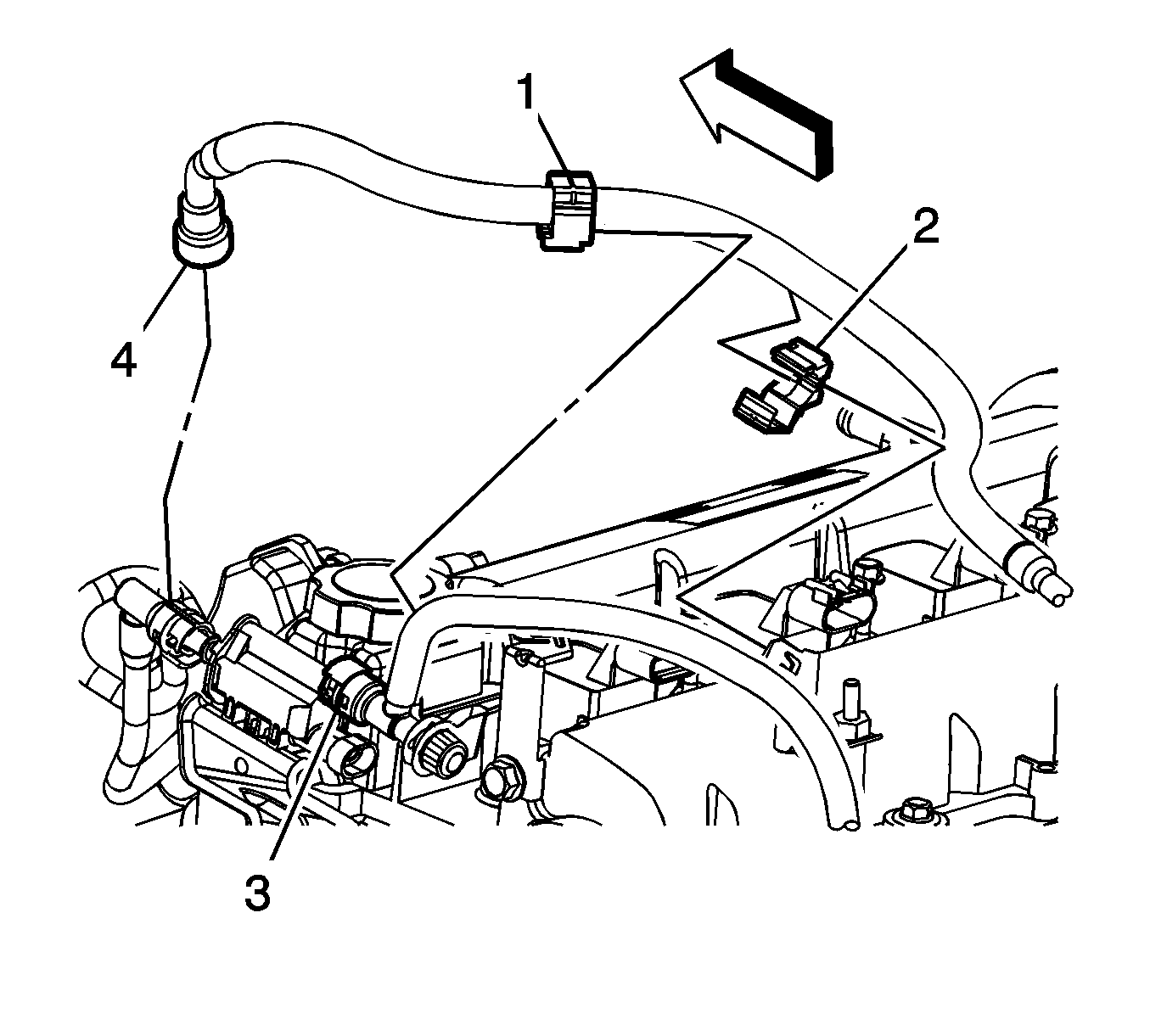
- Ensure that the tires are in the straight forward position. Remove the key from the ignition.
- Raise the hood.
- Disconnect the negative battery cable. Refer to
Battery Negative Cable Disconnection and Connection.
- Relieve the fuel system pressure. Refer to
Fuel Pressure Relief.
- Disconnect the fuel feed line quick connect fitting (4) from the fuel rail. Refer to
Metal Collar Quick Connect Fitting Service.
- Disconnect the evaporative emission (EVAP) line quick connect fitting (3) from the EVAP purge solenoid. Refer to
Plastic Collar Quick Connect Fitting Service.
- Remove the fuel line clips (1, 2) from the engine brackets.
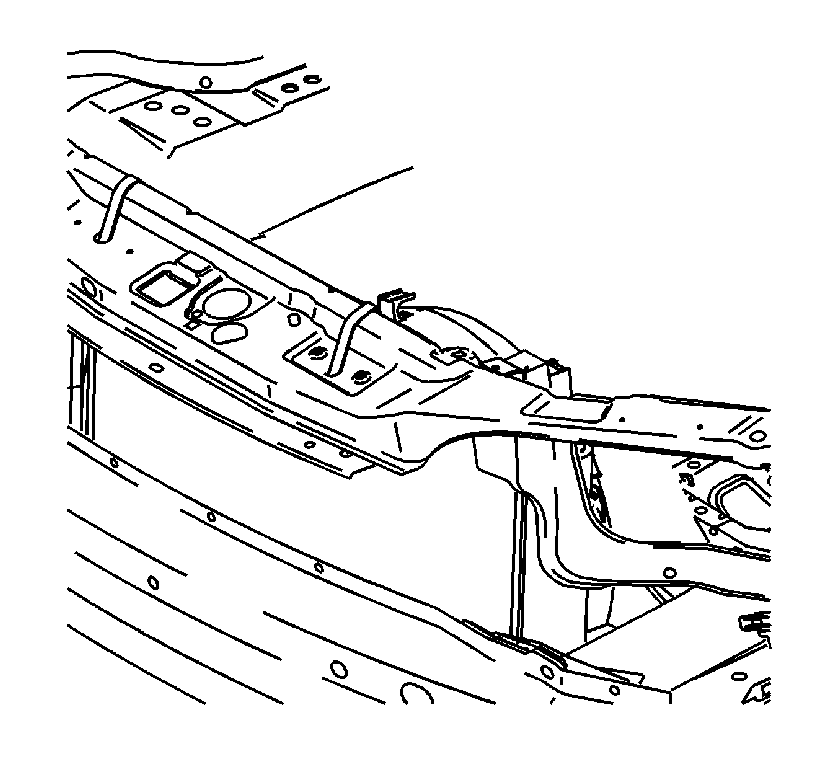
- Drain the cooling system. Refer to
Cooling System Draining and Filling.
- Secure the cooling module to the upper body structure.
- Remove the engine drive belt. Refer to
Drive Belt Replacement.

- Disconnect the cooling fan electrical connector.
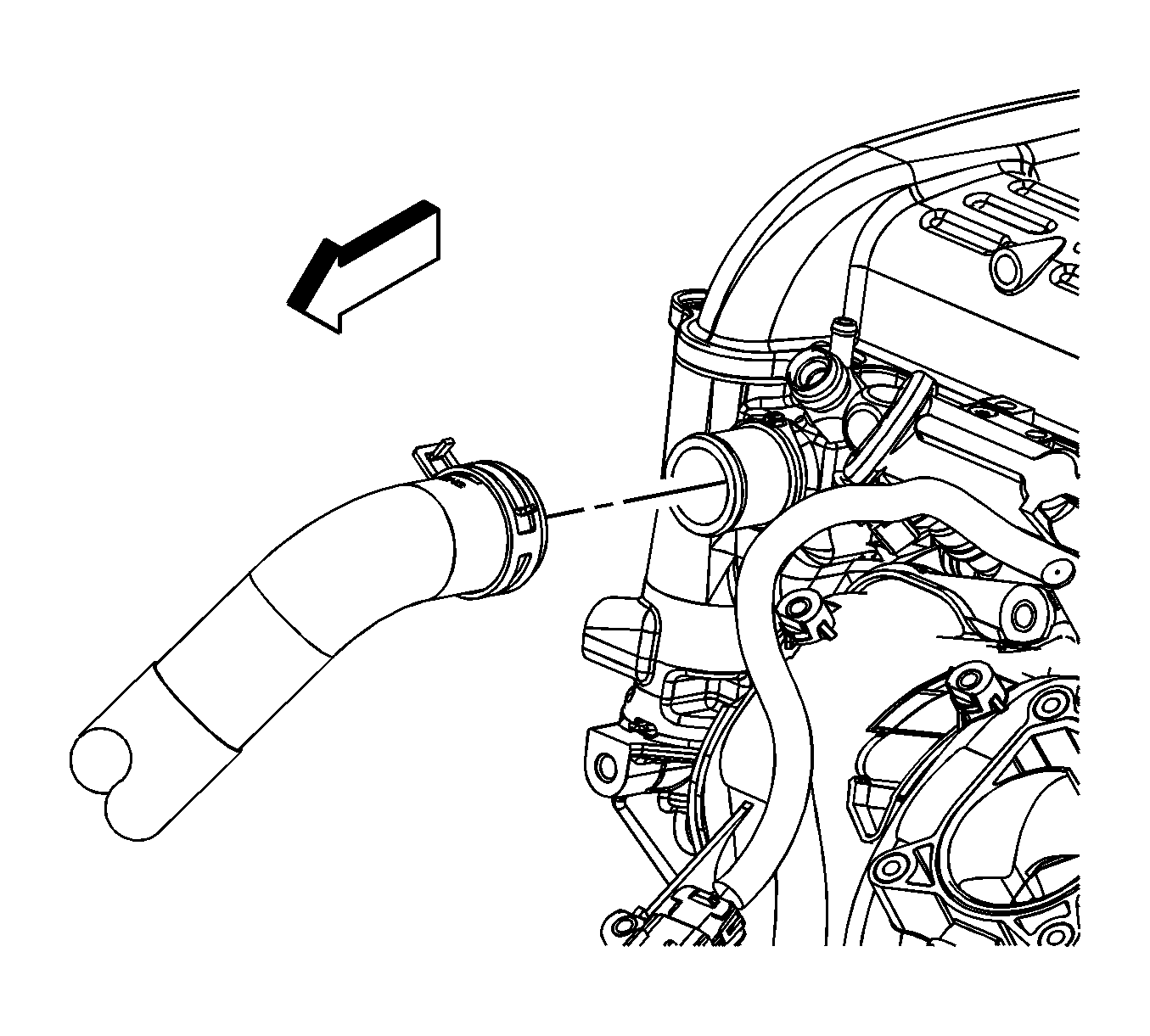
- Reposition the radiator inlet hose clamp at the engine.
- Remove the radiator inlet hose from the engine.
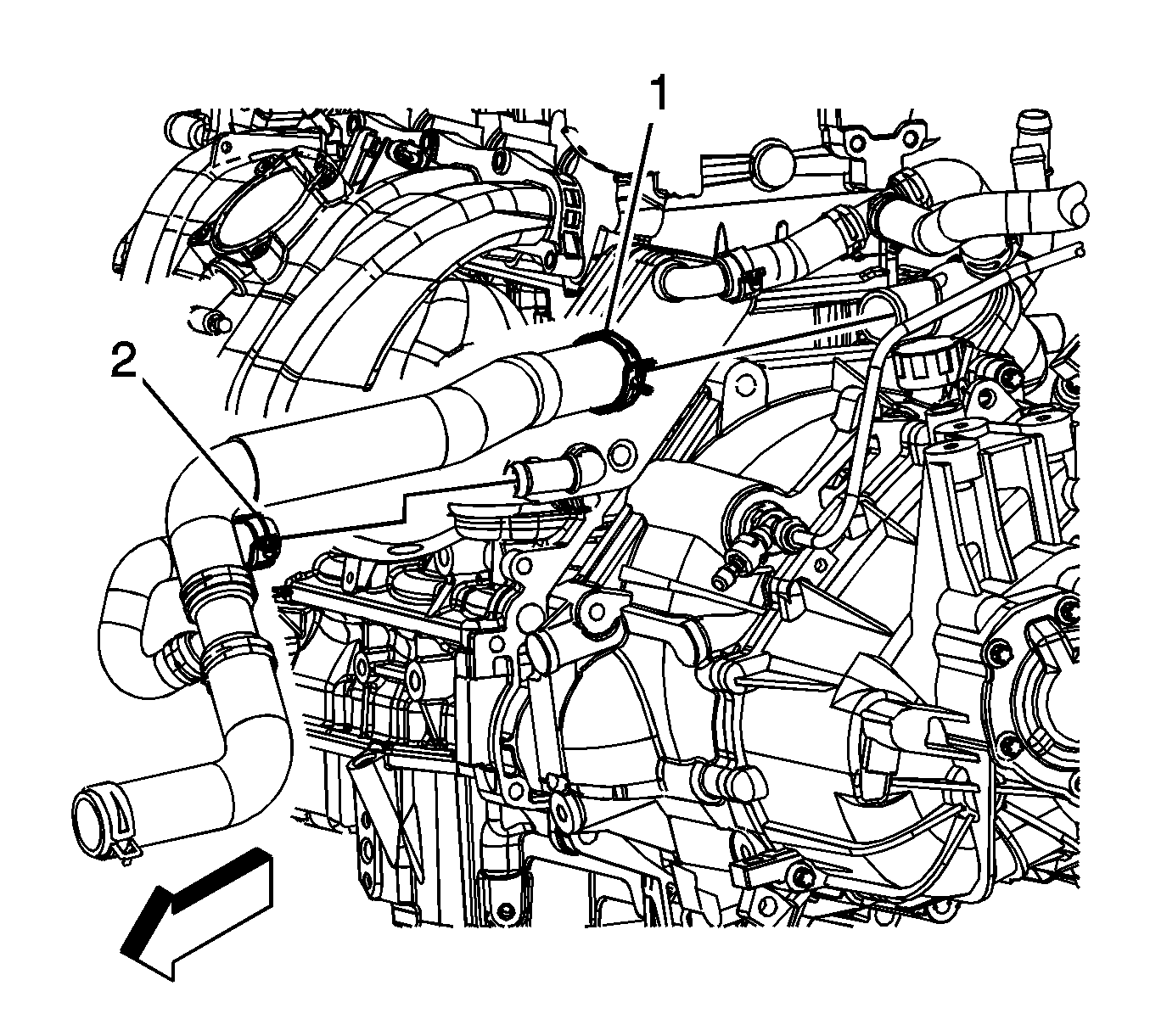
- If the vehicle is equipped with a engine oil cooler perform the following steps, otherwise proceed to step 19.
- Reposition the radiator outlet hose clamp (1) at the water outlet.
- Reposition the radiator outlet hose clamp (2) at the oil cooler.
- Remove the radiator outlet hose from the water outlet.
- Remove the radiator outlet hose from the oil cooler. Proceed to step 23.

- If the vehicle is not equipped with a engine oil cooler, reposition the surge tank outlet hose clamp at the surge tank.
- Remove the surge tank outlet hose from the surge tank.
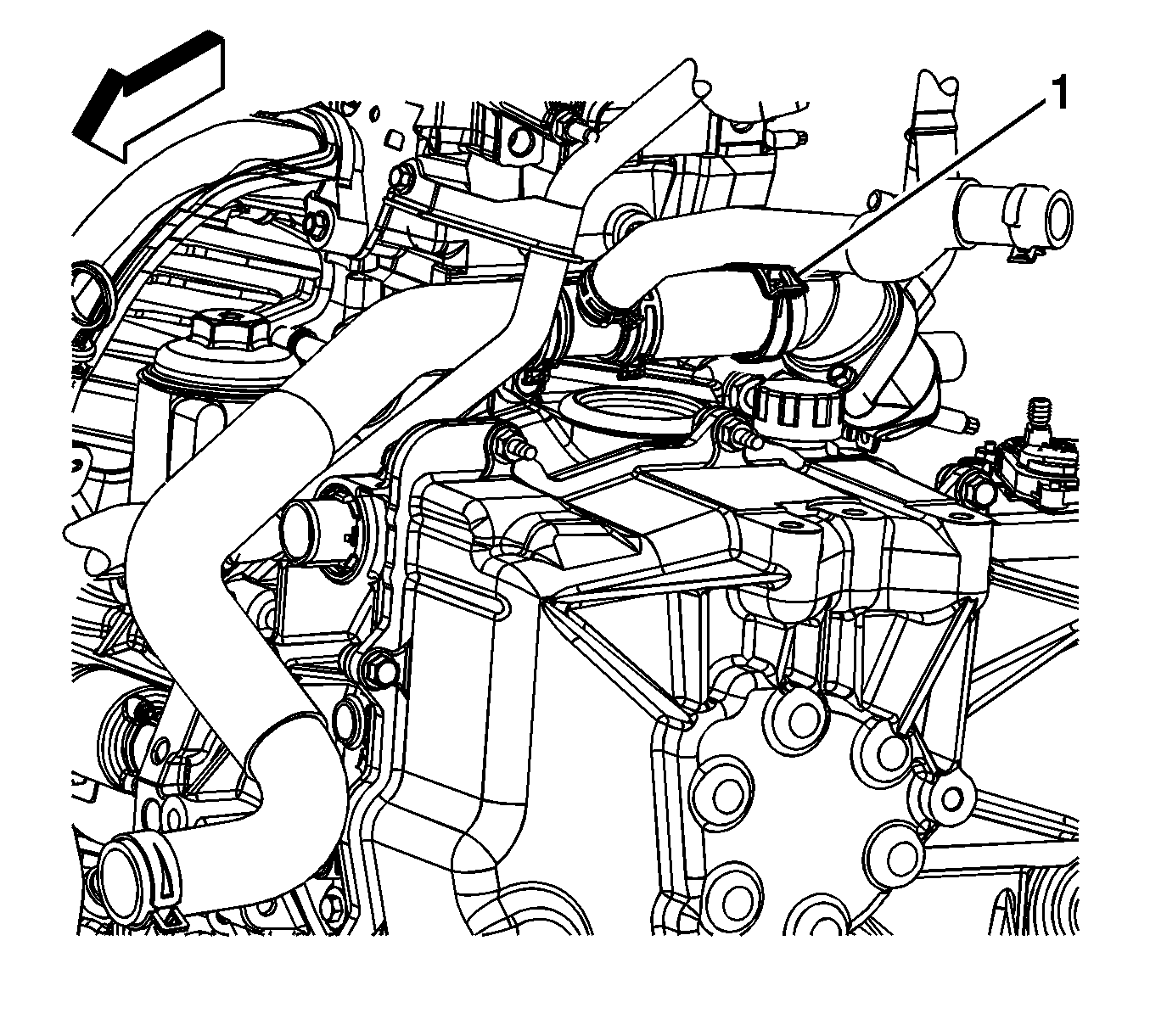
- Reposition the radiator outlet hose clamp (1) at the thermostat cover.
- Remove the radiator outlet hose from the thermostat cover.
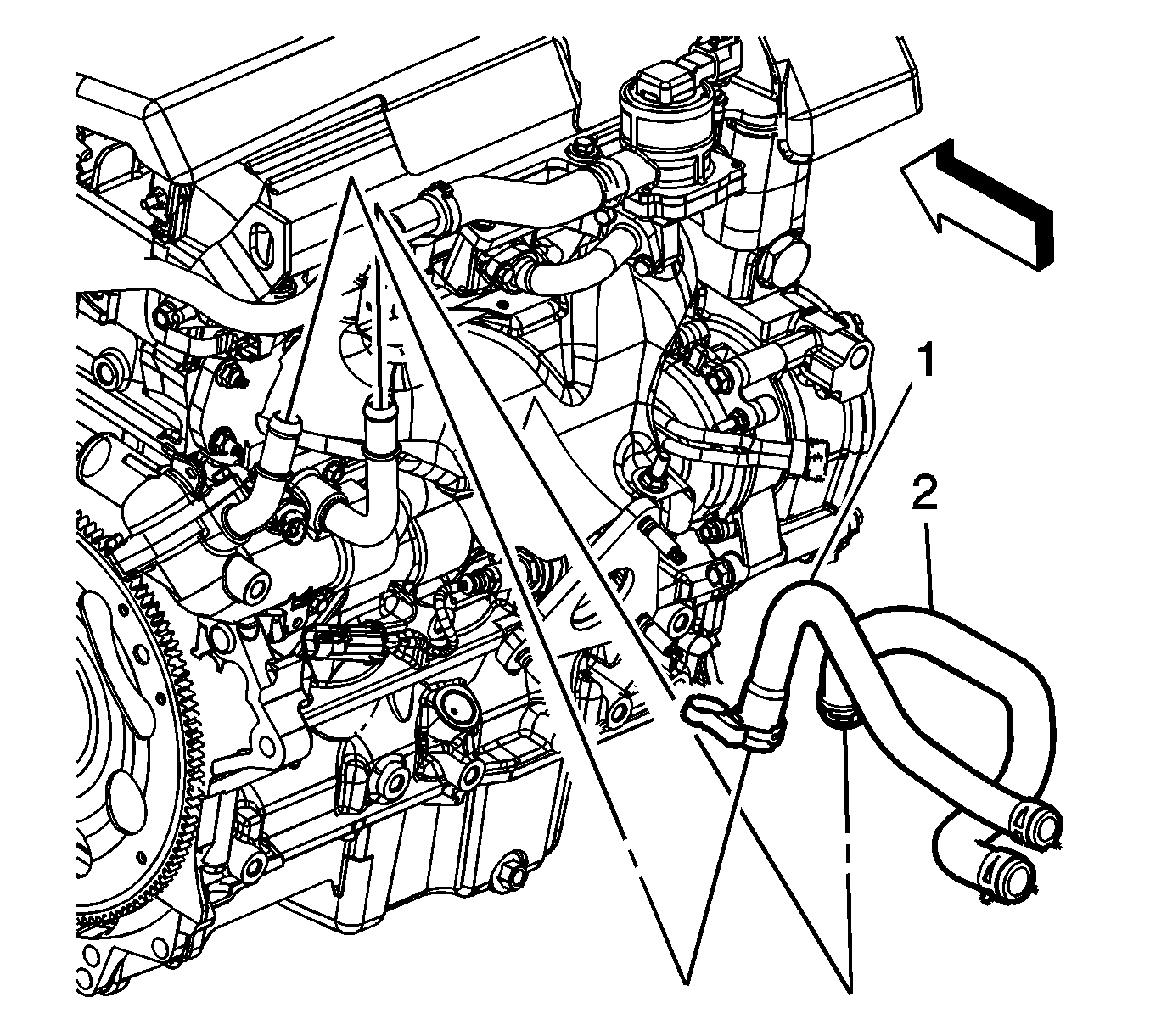
- Reposition the heater inlet and outlet hose clamps at the thermostat housing.
- Remove the heater inlet (2) and outlet (1) hoses from the thermostat housing.
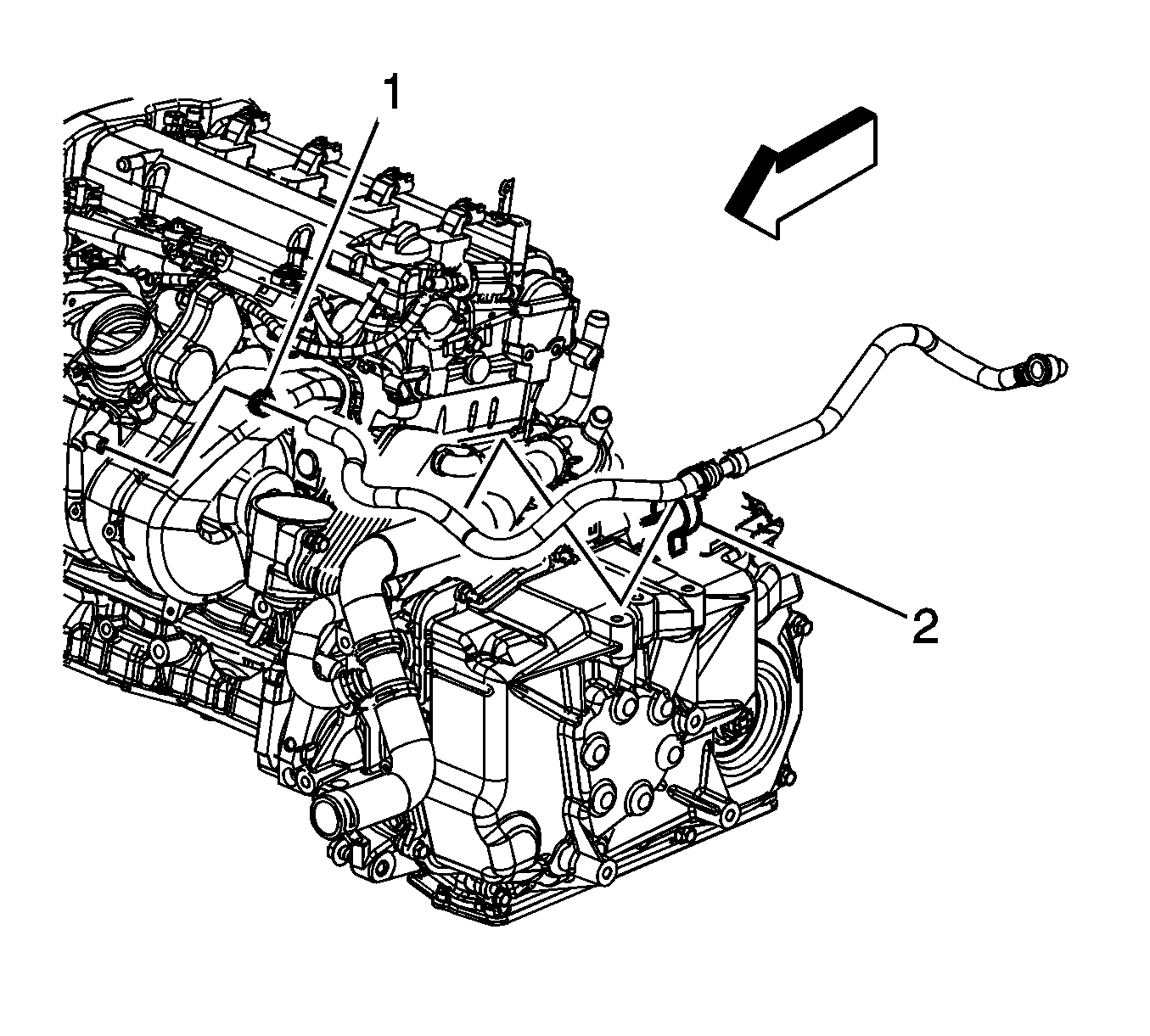
- Reposition the brake booster vacuum hose clamp (2) at the intake manifold.
- Remove the brake booster vacuum hose from the intake manifold. Reposition the hose.

- Disconnect the following electrical connectors:
| • | Throttle actuator control (TAC) (1) |
| • | Manifold absolute pressure (MAP) sensor |
| • | Fuel injector harness (2) |
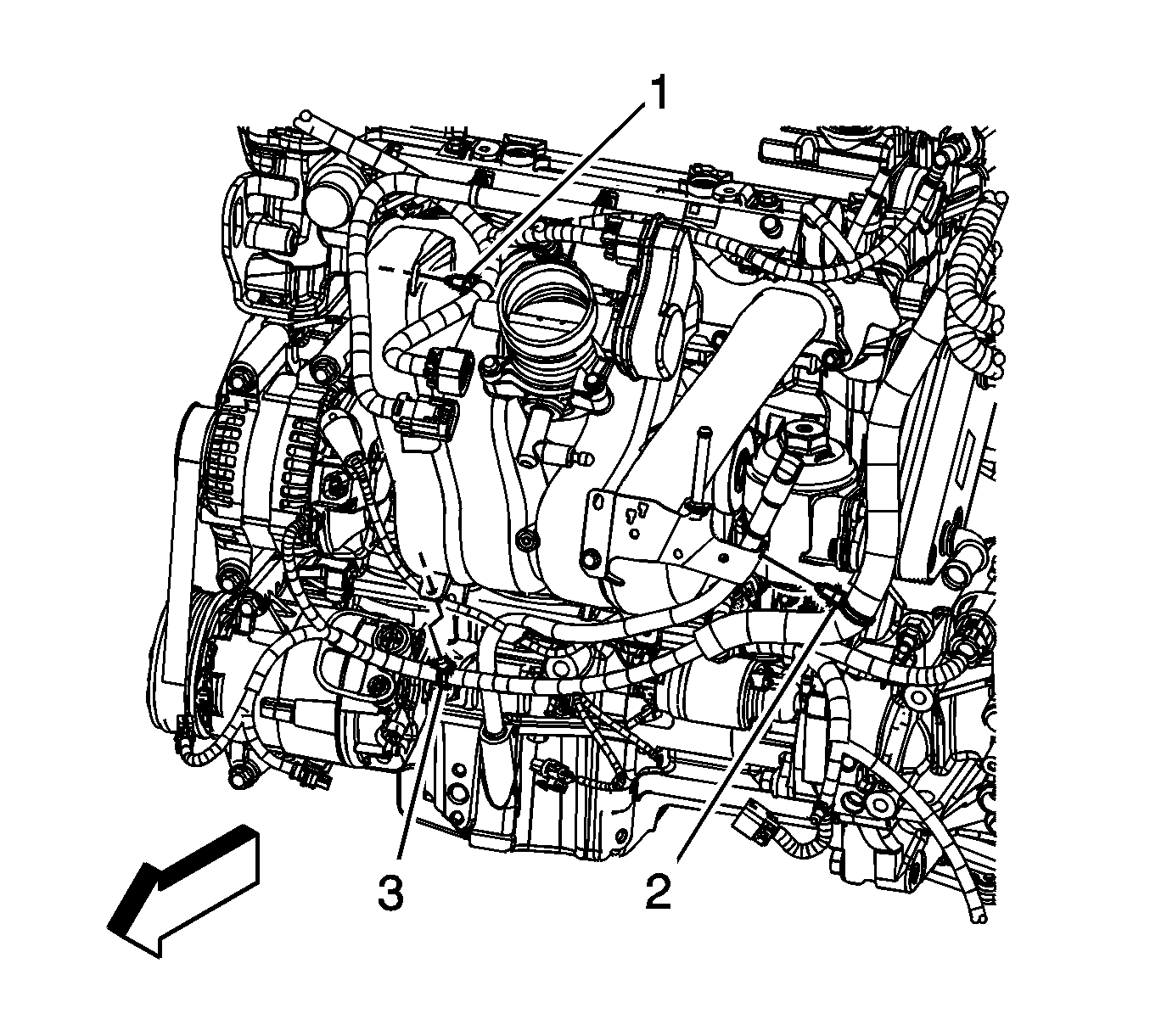
- Disconnect the engine harness clip (2) from the oil level indicator tube.
- Disconnect the engine harness clips (1 and 3) from the intake manifold.
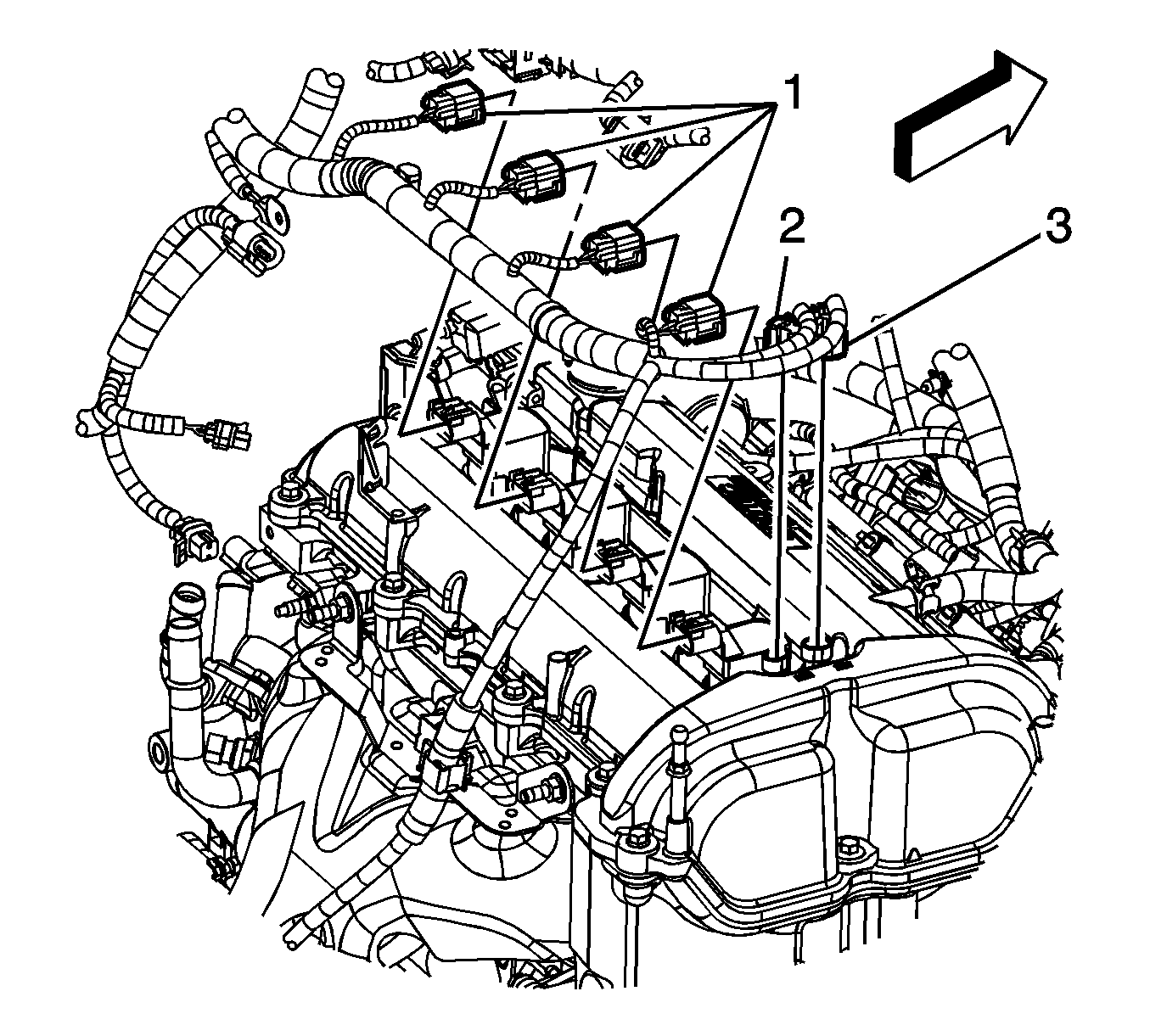
- Disconnect the ignition coils electrical connectors (1).
- Disconnect the intake (3) and exhaust (2) camshaft position actuator electrical connectors.
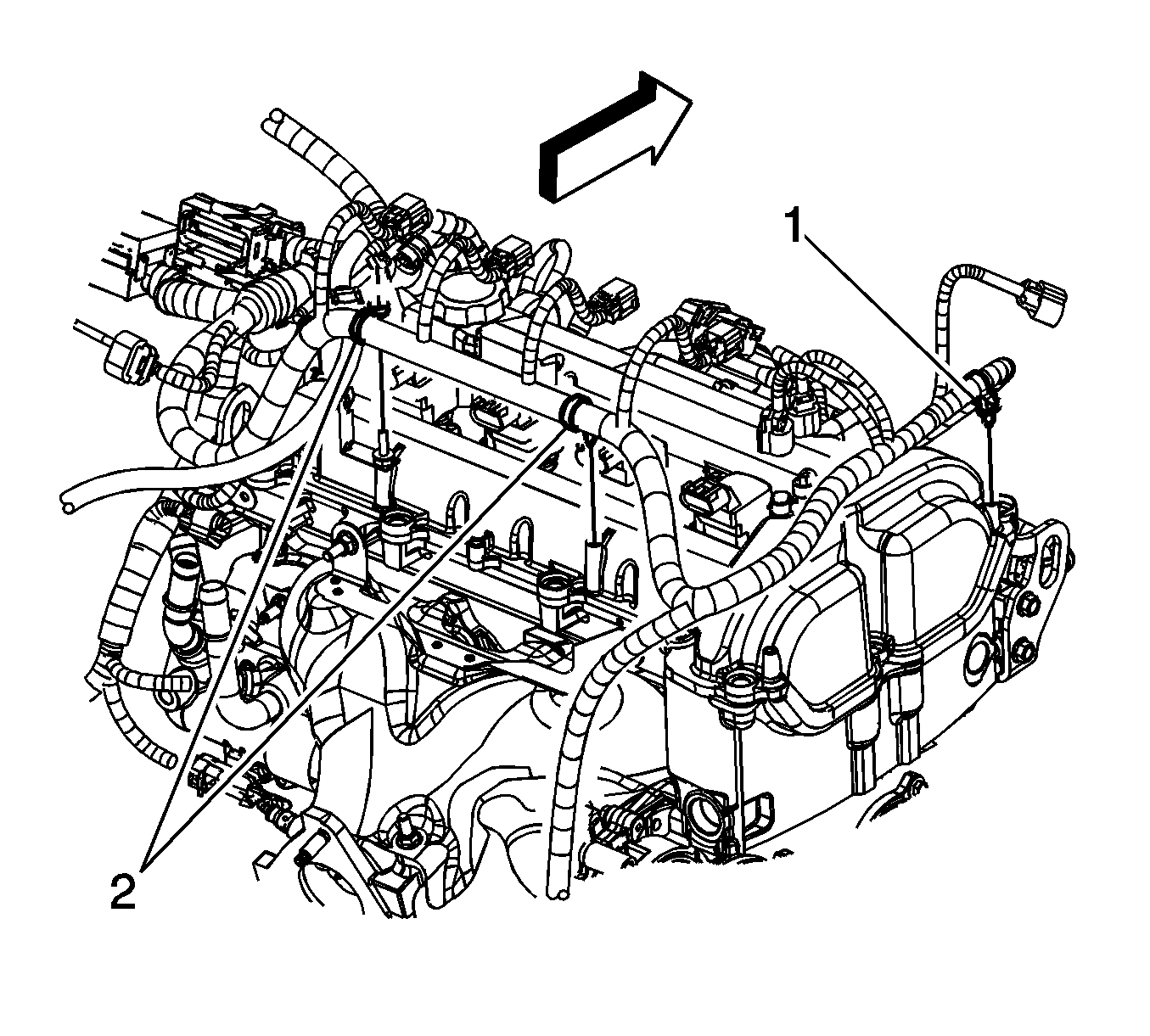
- Remove the engine harness clips (1 and 2) from the camshaft cover.
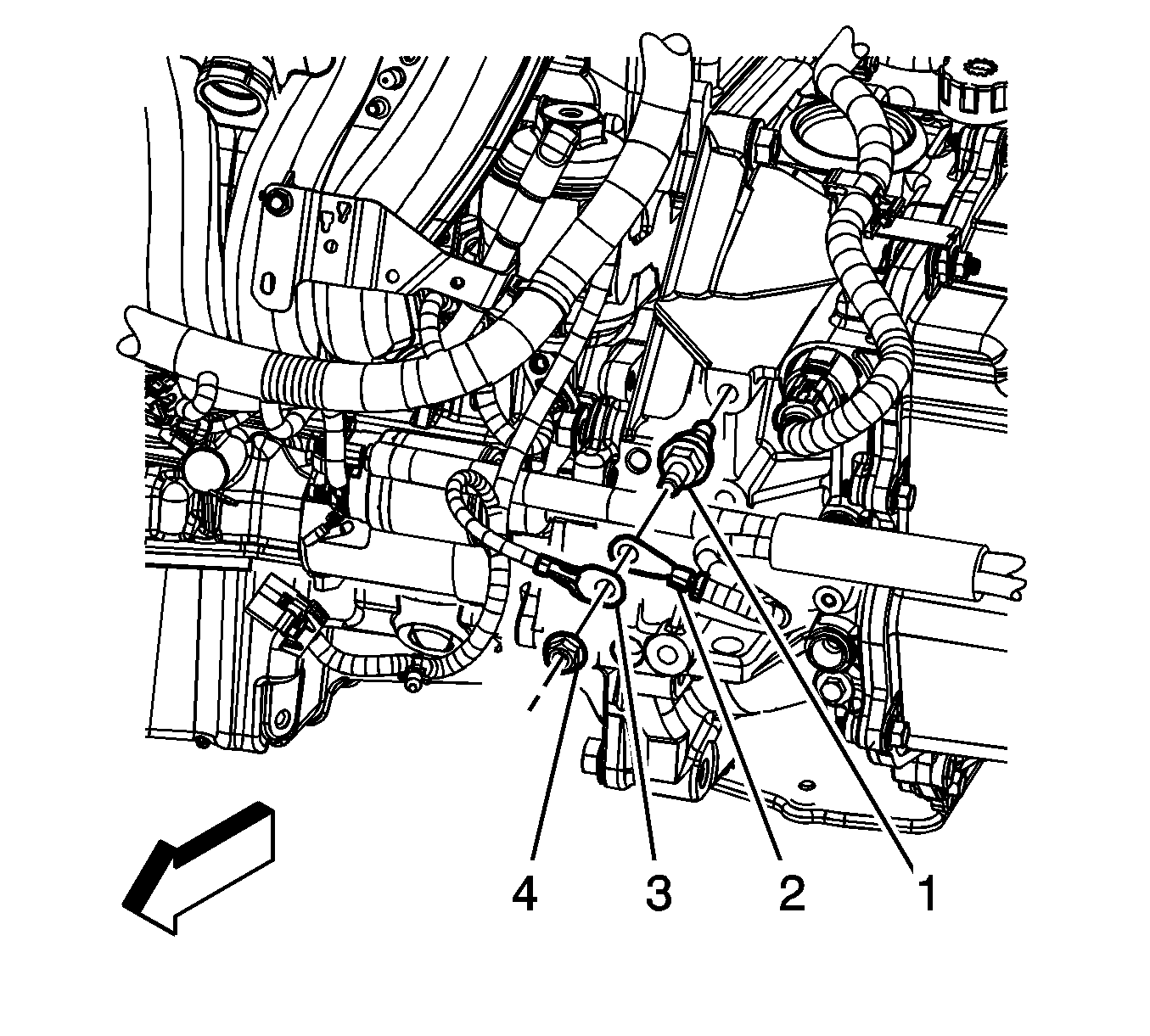
- Remove the negative battery cable ground nut (4).
- Remove the engine harness ground terminal (3) from the stud.
- Remove the negative battery cable ground terminal (2) from the stud.
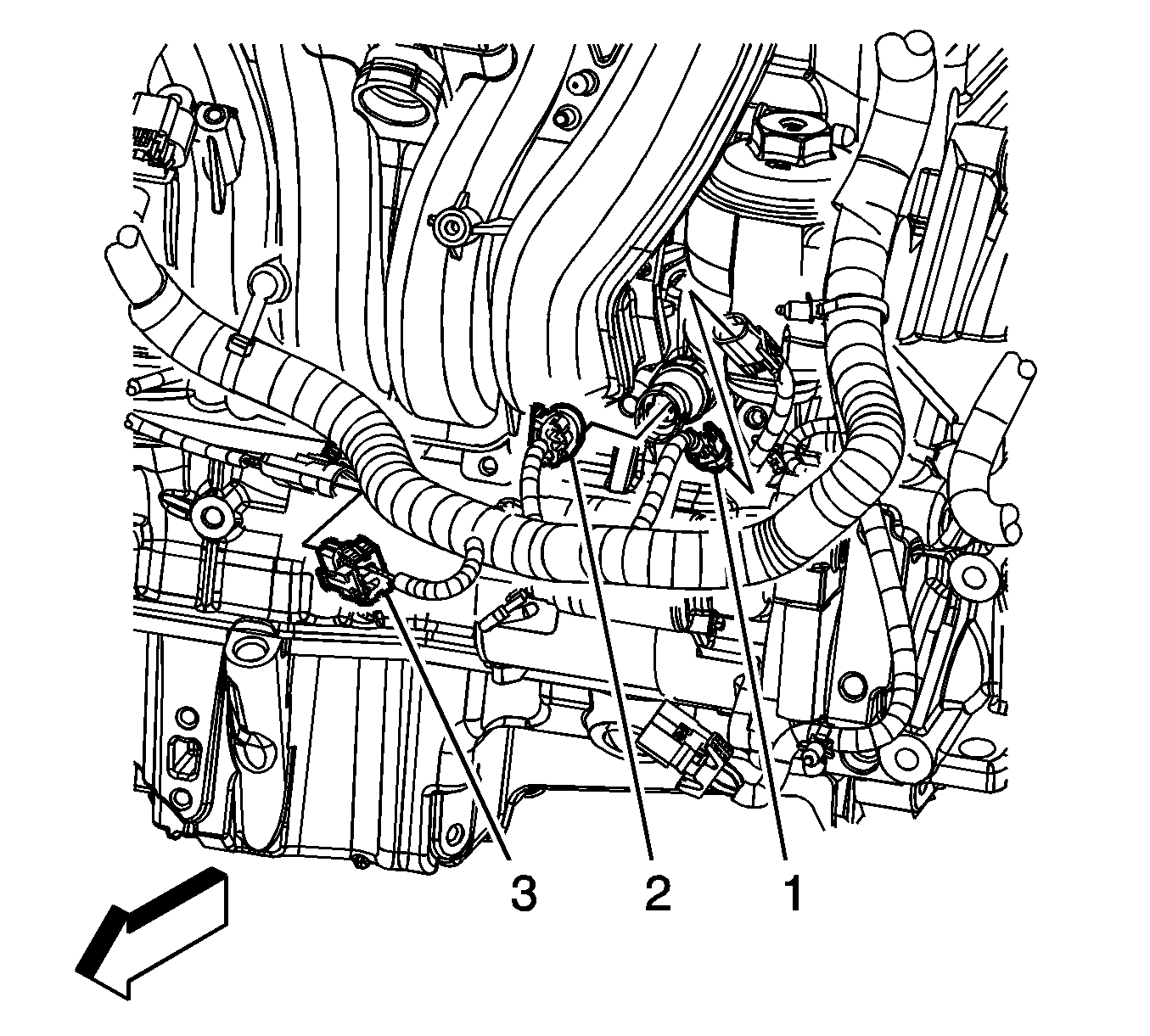
- Disconnect the following engine harness electrical connectors:
| • | Oil pressure sensor (2) |
| • | Crankshaft position (CKP) sensor (1) |
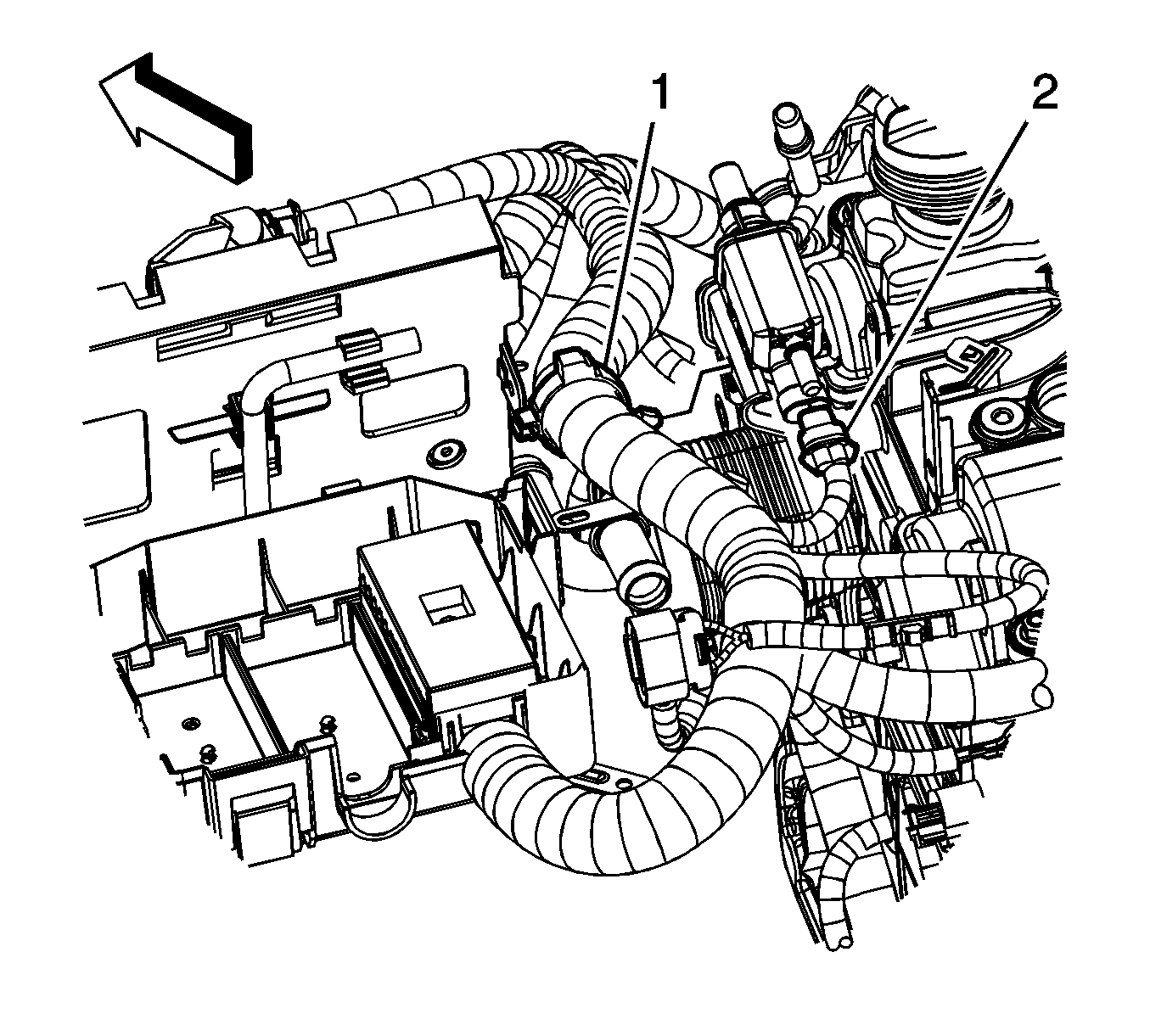
- Disconnect the EVAP purge solenoid electrical connector (2).
- Remove the engine harness clip (1) from the purge solenoid bracket.

- Remove the engine harness ground bolt.
- Reposition the engine harness ground terminal.

- Disconnect the engine harness electrical connector (1) from the air conditioning (A/C) pressure switch.
- Disconnect the engine harness electrical connector (2) from A/C compressor.
- Unbolt and reposition the AC compressor aside.
- Raise and suitably support the vehicle. Refer to
Lifting and Jacking the Vehicle.
- Drain the engine oil. Refer to
Engine Oil and Oil Filter Replacement.

- Remove the transaxle fluid cooler bracket nut.
- Remove the transaxle fluid cooler lines from the transaxle.

- Remove the engine harness clip nut (3) from the engine stud.
- Remove the engine harness clip (1) from the stud.
- If equipped with a automatic transaxle, disconnect the engine harness electrical connector (2) from the vehicle speed sensor (VSS).
- Remove the engine harness clip (3) from the speed sensor.
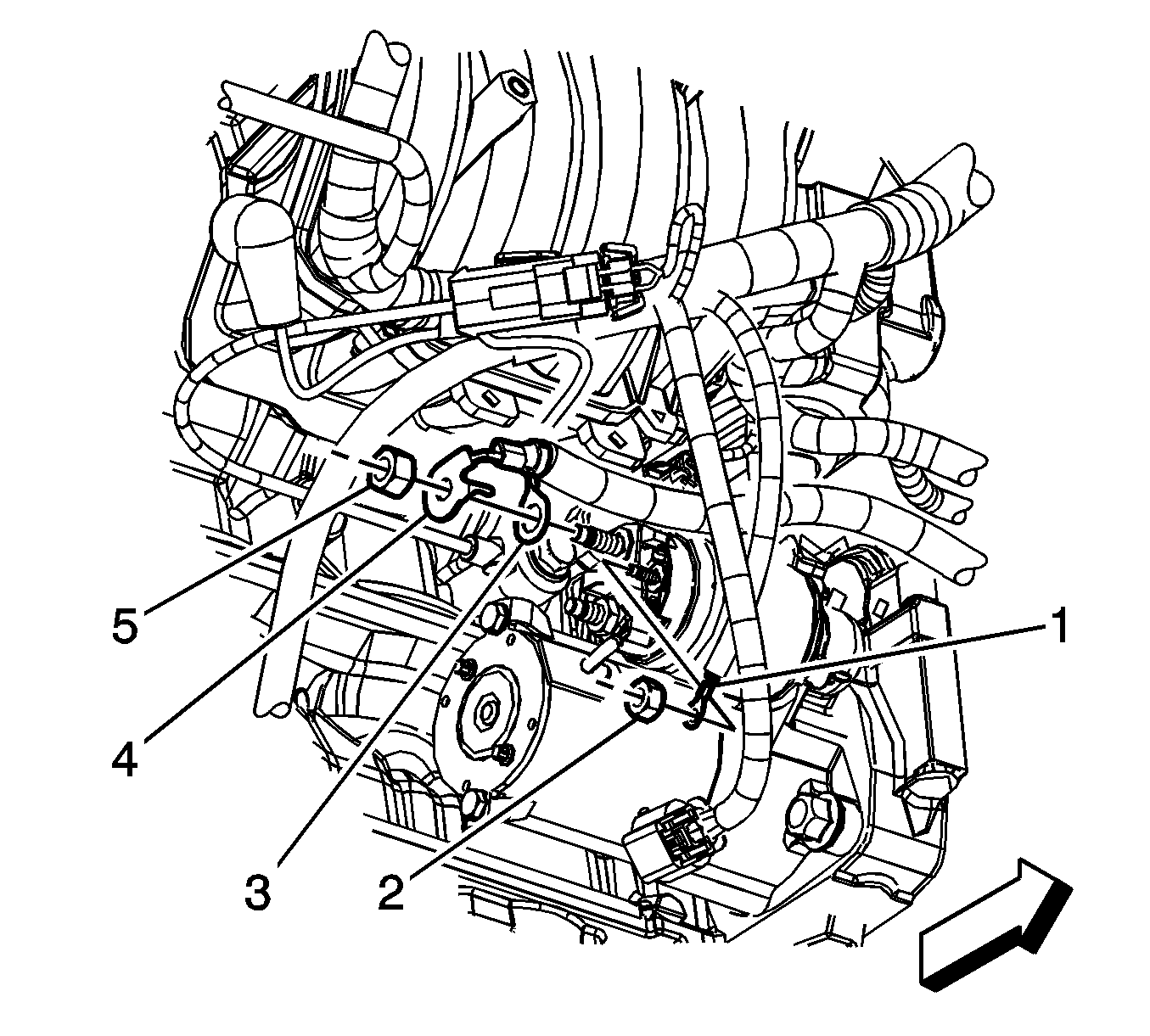
- Remove the positive battery cable lead nut (5) from the starter solenoid.
- Remove the positive battery cable terminal (4) from the starter.
- Remove the engine harness terminal (3) from the starter.
- Remove the engine harness to starter solenoid "S" terminal nut (2).
- Remove the engine harness lead terminals (1) from the starter solenoid.
- Lower the vehicle.

- If equipped with a automatic transaxle, disconnect the engine harness from the transaxle.
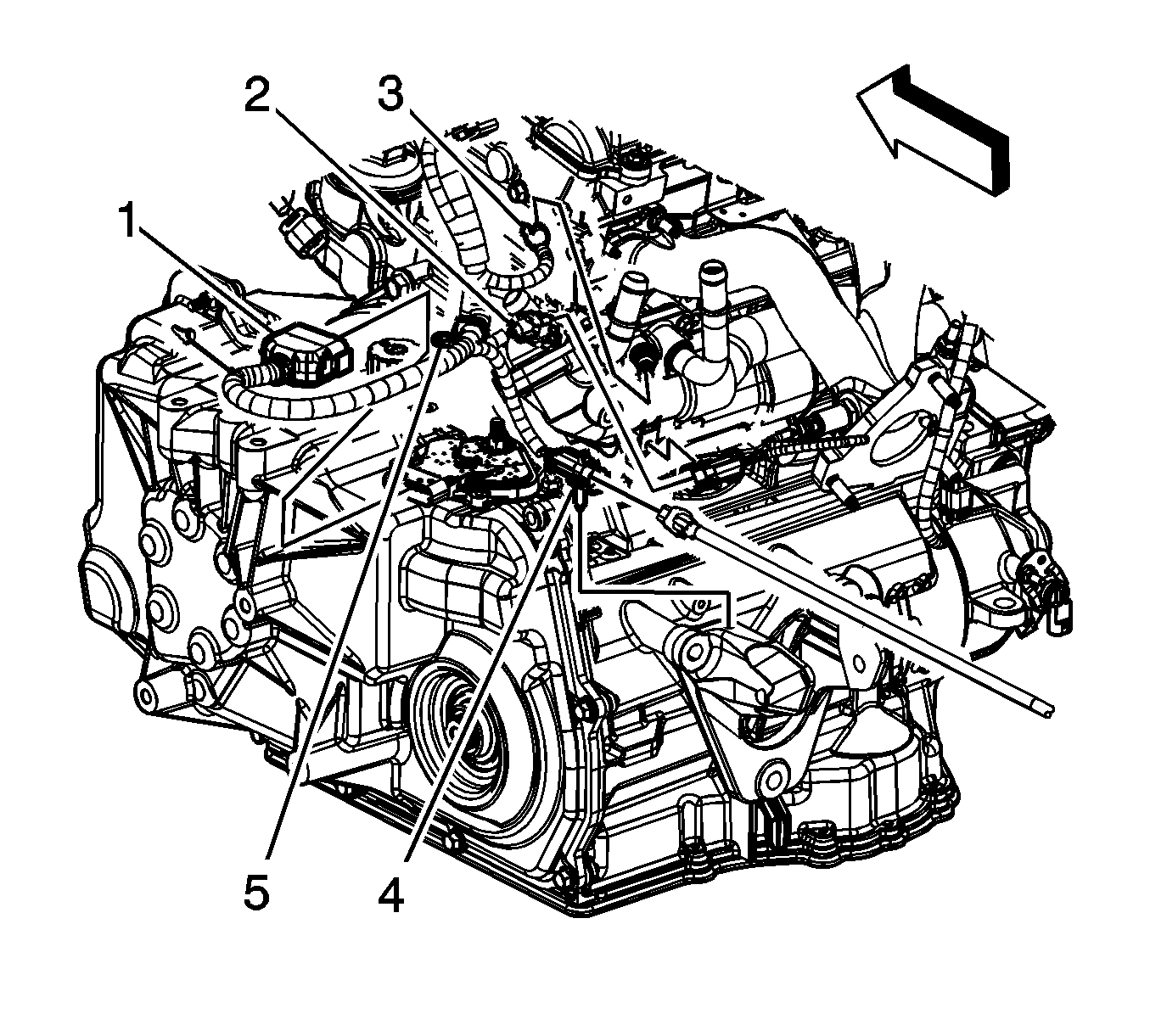
- If equipped with a automatic transaxle, perform the following steps. Disconnect the engine harness electrical connector (2) from the engine coolant temperature (ECT) sensor.
- Remove the heated oxygen sensor (HO2S) connector position assurance (CPA) retainers.
- Disconnect the engine harness electrical connectors (2, 4) from the HO2S.
- Remove the HO2S connector clips from the thermostat housing and engine bracket.
- Disconnect the engine harness electrical connector (1) from the park neutral position switch.
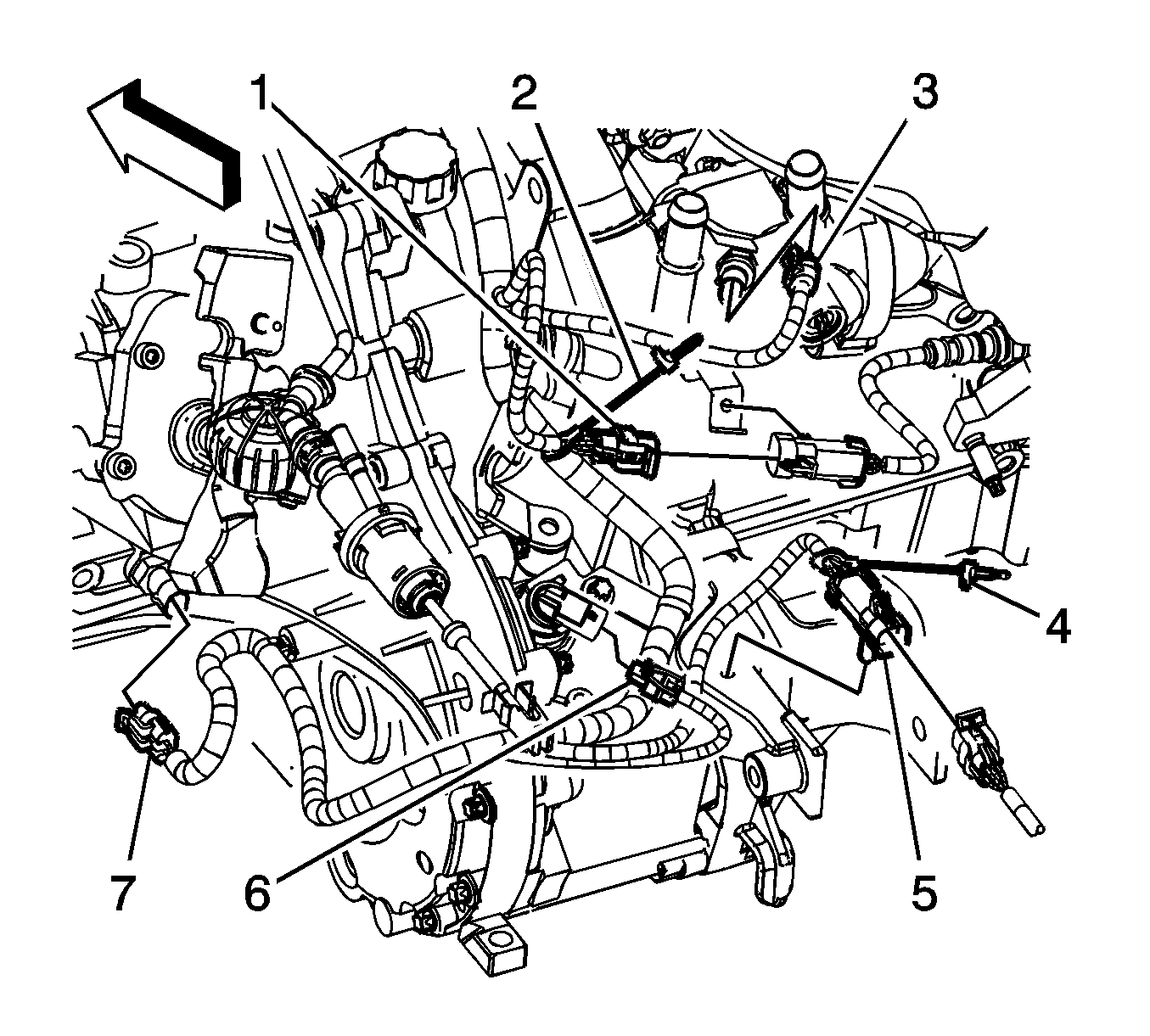
- If equipped with a manual transaxle, disconnect the engine harness electrical connector (6) from the VSS.
- Disconnect the engine harness electrical connector (7) from the back up lamp switch.
- Remove the HO2S CPA retainers (2, 4).
- Disconnect the engine harness electrical connectors (1, 5) from the HO2S.
- Remove the HO2S clips from the engine brackets.
- Gather all engine harness branches are reposition the harness off to the side, out of the way.

- If equipped with a automatic transaxle, disconnect the range selector lever cable from the transaxle lever.
- Remove the range selector lever cable from the transaxle bracket.

- If equipped with a manual transaxle, disconnect the range selector and shift lever cables from the transaxle levers.
- Remove the range selector and shift lever cables from the transaxle bracket.
- Remove the catalytic converter. Refer to
Catalytic Converter Replacement.
- Lower the vehicle.
- Insert blocks of wood between the powertrain and the frame, in order to support the powertrain.
- Remove the engine mount. Refer to
Engine Mount Replacement.

- Remove the transaxle mount to transaxle bolts.
- Raise the vehicle.
- Disconnect the stabilizer links from the stabilizer bar. Refer to
Stabilizer Shaft Link Replacement.
- Disconnect the outer tie rod ends from the steering knuckles. Refer to
Steering Linkage Outer Tie Rod Replacement.
- Disconnect the intermediate shaft from the steering gear. Refer to
Intermediate Steering Shaft Replacement.
- Disconnect the lower control arms from the steering knuckles. Refer to
Lower Control Arm Replacement.

- Using a paint pen or magic marker, mark the frame to body position.
- Lower the vehicle to about 3 feet off the ground.
- Position a engine lift table under the frame.
- Place wood blocks on top of the lift table between the table and the frame.
- Lower the vehicle until the frame is resting on the blocks of wood.
- Slowly loosen/remove the frame bolts using the following sequence:
| 89.1. | Loosen/remove the front frame bolts. |
| 89.2. | Loosen/remove the rear frame bolts. |
- Slowly raise the vehicle away from the powertrain assembly.
- Slide the lift table out from under the vehicle.
- Attach the engine lift hoist to the engine lift hooks.
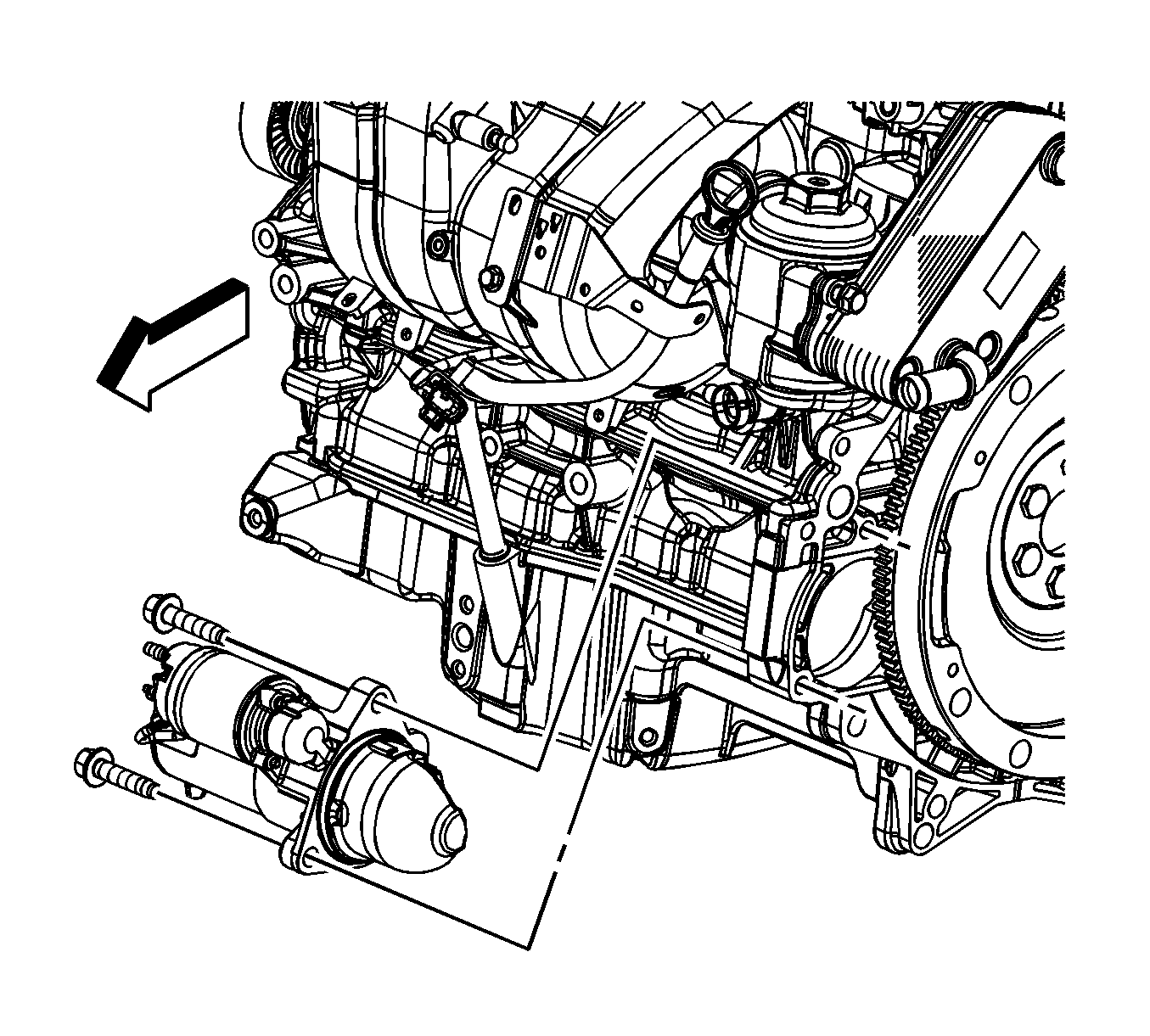
- Remove the starter bolts and starter.

- If equipped with a automatic transaxle, remove the torque converter housing access plug.

- If equipped with a automatic transaxle, remove the torque converter bolts.

- Remove the transaxle brace bolts and brace.

- If equipped with a manual transaxle, remove the transaxle to engine bolts/stud.

- If equipped with a automatic transaxle, remove the transaxle to engine bolts/stud.
- Separate the engine from the transaxle.
- If equipped with a manual transaxle, remove the clutch pressure plate and disc. Refer to
Clutch Pressure and Driven Plate Replacement.
- Remove the following components:
| • | The engine mount bracket |
| • | The engine block heater |
- Using a engine hoist, install the engine to a engine stand.
Installation Procedure

- Using a engine hoist, remove the engine from the engine stand.
- Install the following components:
| • | The engine mount bracket |
| • | The engine block heater |
- If equipped with a manual transaxle, install the clutch pressure plate and disc. Refer to
Clutch Pressure and Driven Plate Replacement.
- Install the engine to the transaxle.
Caution: Refer to Fastener Caution in the Preface section.
- If equipped with a automatic transaxle, install the transaxle to engine bolts/stud and tighten to
75 N·m (55 lb ft).

- If equipped with a manual transaxle, install the transaxle to engine bolts/stud and tighten to
75 N·m (55 lb ft).

- Install the transaxle brace and bolts and tighten to
50 N·m (37 lb ft).

- If equipped with a automatic transaxle, install the torque converter bolts and tighten to
62 N·m (46 lb ft).

- If equipped with a automatic transaxle, install the torque converter housing access plug.

- Install the starter and bolts and tighten to
40 N·m (30 lb ft).

- Remove the engine lift hoist from the engine lift hooks.
- Slide the lift table under the vehicle.
- Slowly lower the vehicle until it aligns with the alignment marks made during the removal.
- Install and tighten the frame bolts to
100 N·m (74 lb ft) plus and additional 180 degrees.
- Raise the vehicle until the lift table can be removed from under the vehicle.
- Remove the lift table.

- Install the transaxle fluid cooler lines to the transaxle.
- Install the transaxle fluid cooler bracket nut and tighten to
7 N·m (62 lb in).

- Connect the lower control arms to the steering knuckles. Refer to
Lower Control Arm Replacement.
- Connect the intermediate shaft to the steering gear. Refer to
Intermediate Steering Shaft Replacement.
- Connect the outer tie rod ends to the steering knuckles. Refer to
Steering Linkage Outer Tie Rod Replacement.
- Connect the stabilizer links to the stabilizer bar. Refer to
Stabilizer Shaft Link Replacement.
- Lower the vehicle.
- Install the transaxle mount to transaxle bolts and tighten to
45 N·m (33 lb ft).

- Install the engine mount. Refer to
Engine Mount Replacement.
- Remove the blocks of wood from between the powertrain and the frame.
- Install the catalytic converter. Refer to
Catalytic Converter Replacement.
- Lower the vehicle.
Note: Ensure that the black cable is installed in the top notch of the transaxle bracket and the white cable in installed in the bottom notch of the transaxle bracket.
- If equipped with a manual transaxle, install the range selector and shift lever cables to the transaxle bracket.
- Connect the range selector and shift lever cables to the transaxle levers.

- If equipped with a automatic transaxle, install the range selector lever cable to the transaxle bracket.
- Connect the range selector lever cable to the transaxle lever.

- Gather all engine harness branches and position the harness over the engine.
- If equipped with a manual transaxle, perform the following steps. Install the HO2S clips to the engine brackets.
- Connect the engine harness electrical connectors (1, 5) to the HO2S.
- Install the HO2S CPA retainers (2, 4).
- Connect the engine harness electrical connector (7) to the back up lamp switch.
- Connect the engine harness electrical connector (1) to the VSS.

- If equipped with a automatic transaxle, perform the following steps. Connect the engine harness electrical connector (1) to the park neutral position switch.
- Install the engine harness clips to the thermostat housing and engine brackets.
- Connect the engine harness electrical connectors (2, 4) to the HO2S.
- Install the HO2S CPA retainers.
- Connect the ECT sensor electrical connector (1).

- If equipped with a automatic transaxle, connect the engine harness to the transaxle.
- Raise the vehicle.

- Install the engine harness lead terminal (1) to the starter solenoid.
- Install the engine harness to starter solenoid "S" terminal nut (2) and tighten to
3 N·m (27 lb in).
- Install the engine harness terminal (3) to the starter.
- Install the positive battery cable terminal (4) to the starter.
- Install the positive/negative battery cable lead nut (5) to the starter solenoid and tighten the nut to
17 N·m (13 lb ft).

- Install the engine harness clip (3) to the speed sensor.
- Connect the engine harness electrical connector (2) to the VSS.
- Install the engine harness clip (1) to the stud.
- Install the engine harness clip nut (3) to the engine stud and tighten the nut to
50 N·m (37 lb ft).

- Lower the vehicle.
- Reposition and install the AC compressor and tighten the bolts to
50 N·m (37 lb ft).
- Connect the engine harness electrical connector (2) to the A/C compressor.
- Connect the engine harness electrical connector (1) to the A/C pressure switch.

- Position the engine harness ground terminal to the engine block.
- Install the engine harness ground bolt and tighten to
25 N·m (18 lb ft).

- Connect the EVAP purge solenoid electrical connector (2).
- Install the engine harness clip (1) to the EVAP purge solenoid bracket.

- Connect the following electrical connectors:
| • | Oil pressure sensor (2) |

- Install the negative battery cable ground terminal (2) to the stud.
- Install the engine harness ground terminal (3) to the stud.
- Install the negative battery cable ground nut (4) and tighten to
10 N·m (89 lb in).

- Install the engine harness clips (1 and 2) to the camshaft cover.

- Connect the intake (3) and exhaust (2) camshaft position actuator electrical connectors.
- Connect the ignition coils electrical connectors (1).
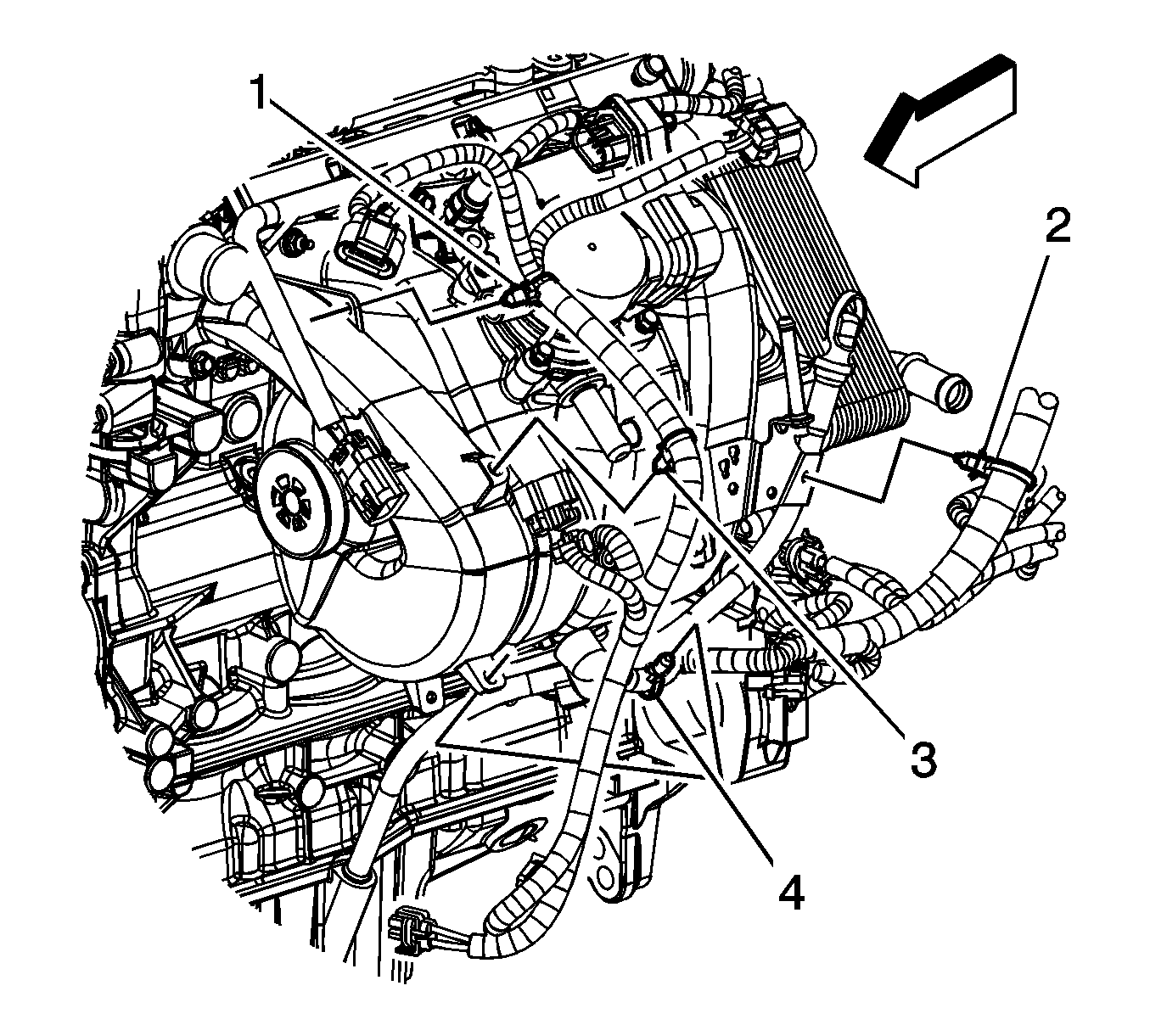
- Connect the engine harness clips (1, 3 and 4) to the intake manifold.
- Connect the engine harness clip (2) to the oil level indicator tube.

- Connect the following electrical connectors:
| • | Fuel injector harness (2) |

- Install the brake booster vacuum hose to the intake manifold.
- Position the brake booster vacuum hose clamp (1) at the intake manifold.

- Install the heater inlet and outlet hoses to the thermostat housing.
- Position the heater inlet (2) and outlet hose (1) clamps at the thermostat housing.

- If the vehicle is not equipped with a engine oil cooler perform the following steps, otherwise proceed to step 82.
- Install the surge tank outlet hose to the surge tank.
- Position the surge tank outlet hose clamp at the surge tank.

- Install the radiator outlet hose to the thermostat cover.
- Position the radiator outlet hose clamp (1) at the thermostat cover. Proceed to step 86.

- If the vehicle is equipped with a engine oil cooler perform the following steps, install the radiator outlet hose to the oil cooler.
- Install the radiator outlet hose to the water outlet.
- Position the radiator outlet hose clamp (2) at the oil cooler.
- Position the radiator outlet hose clamp (1) at the water outlet.

- Install the radiator inlet hose to the engine.
- Position the radiator inlet hose clamp at the engine.

- Connect the cooling fan electrical connector.

- Install the engine drive belt. Refer to
Drive Belt Replacement.
- Unsecure the cooling module from the upper body structure.
- Fill the cooling system. Refer to
Cooling System Draining and Filling.
- Check and fill the transaxle fluid as needed.

- Connect the EVAP line quick connect fitting (3) to the EVAP purge solenoid. Refer to
Plastic Collar Quick Connect Fitting Service.
- Connect the fuel feed line quick connect fitting (4) to the fuel rail. Refer to
Metal Collar Quick Connect Fitting Service.
- Install the fuel line clips (1, 2) to the engine brackets.
- Fill the engine with oil. Refer to
Engine Oil and Oil Filter Replacement.
- Connect the negative battery cable. Refer to
Battery Negative Cable Disconnection and Connection.
- Close the hood.
- Road test the vehicle.




































































